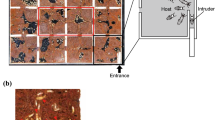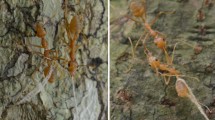Abstract
Unlike all other social spiders, the social huntsman spider, Delena cancerides, has been reported to rapidly respond to non-nestmates with lethal aggression, similar to the behavior of some eusocial insects. We tested for the presence of nestmate recognition in D. cancerides under laboratory conditions by introducing 105 unrelated alien conspecifics into foreign colonies and comparing their behavior to 60 control spiders removed and returned to their natal colony. Spiders demonstrated nestmate recognition by investigating alien spiders far more than nestmates and by resting closer to nestmates than to aliens. Serious attacks or deaths occurred in 23% of all trials; however, aggression was not directed significantly more toward aliens than to nestmates. Most notably, aggression was largely mediated by the adult females (resident or alien), who were most likely to attack or kill other subadult or mature individuals. Young individuals (resident or alien) were largely immune from serious aggression. Spiders recently collected from the field tended to be more aggressive than spiders born and raised in the laboratory, possibly due to blurring of recognition cues related to laboratory husbandry. Our findings support the prediction that nestmate recognition should evolve when there is a benefit to discriminating against non-kin, as in this social spider system where foraging individuals may enter a foreign colony and the colony retreat is a limited resource.

Similar content being viewed by others
References
Anthony C.D. 2003. Kinship influences cannibalism in the wolf spider, Pardosa milvina. J. Insect Behav. 16: 23–36
Avilés L. 1997. Causes and consequences of cooperation and permanent-sociality in spiders. In: The Evolution of Social Behavior in Insects and Arachnids (Choe J. and Crespi B., Eds), Cambridge University Press, New York. pp 476–498
Avilés L. and Tufiño P. 1998. Colony size and individual fitness in the social spider Anelosimus eximius. Am. Nat. 152: 403–418
Beavis A.S., Rowell D.M. and Evans T.A. 2007. Cannibalism and kin recognition in Delena cancerides (Araneae: Sparassidae), a social huntsman spider. J. Zool. 271: 233–237
Bilde T. and Lubin Y. 2001. Kin recognition and cannibalism in a subsocial spider. J. Evol. Biol. 14: 959–966
Bilde T., Maklakov A.A., Taylor P.W. and Lubin Y. 2002. State dependent decisions in nest selection by a web-building spider. Anim. Behav. 64: 447–452
Bilde T., Coates K.S., Birkhofer K., Bird T., Maklakov A.A., Lubin Y. and Avilés L. 2007. Survival benefits select for group living in a social spider despite reproductive costs. J. Evol. Biol. 20: 2412–2426
Breed M.D., Welch C.K. and Cruz R. 1994. Kin discrimination within honey bee (Apis mellifera) colonies: an analysis of the evidence. Behav. Process. 33: 25–40
Breed M.D., Garry M.F., Pearce A.M., Hibbard B.E., Bjostad L.B. and Page R.E. 1995. The role of wax comb in honey bee recognition. Anim. Behav. 50: 489–496
Buser P. 2002. Silk attraction: base of group cohesion and collective behaviours in social spiders. C.R. Biol. 325: 1153–1157
Buskirk R. 1981. Sociality in the Arachnida. In: Social Insects, vol. 2 (Hermann H.R., Ed), Academic Press, New York. pp 282–367
Clément J.-L. and Bagnères A.-G. 1998. Nestmate recognition in termites. In: Pheromone Communication in Social Insects (Vander Meer R.K., Breed M.D., Espelie K.E. and Winston M.L., Eds), Westview Press, Boulder CO. pp 126–155
Dahbi A. and Lenoir A. 1998. Nest separation and the dynamics of the Gestalt odor in the polydomous ant Cataglyphis iberica (Hymenoptera, Formicidae). Behav. Ecol. Sociobiol. 42: 349–355
Evans T.A. 1995. Two new species of social crab spiders of the genus Diaea from eastern Australia, their natural history and distribution. In: Australasian Spiders and Their Relatives: Papers Honouring Barbara York Main (Harvey M.S., Ed), Records of the Western Australian Museum supplement 52, Western Australian Museum, Perth. pp 151–158
Evans T.A. 1999. Kin recognition in a social spider. Proc. R. Soc. Lond. B Biol. Sci. 266: 287–292
Fadao T., Tingzhen W. and Yajun Z. 2000. Inbreeding avoidance and mate choice in the mandarin vole (Microtus mandarinus). Can. J. Zool. 78: 2119–2125
Hamilton W.D. 1964. The genetical evolution of social behavior. J. Theor. Biol. 7: 1–52
Hölldobler B. and Wilson E.O. 1990. The Ants. The Belknap Press of Harvard University Press, Cambridge, MA. 732 pp
Holmes W.G. 2004. The early history of Hamiltonian-based research on kin recognition. Ann. Zool. Fenn. 41: 691–711
Jones T.C. and Parker P.G. 2002. Delayed juvenile dispersal benefits both mother and offspring in the cooperative spider Anelosimus studiosus (Araneae: Theridiidae). Behav. Ecol. 13: 142–148
Lubin Y. and Bilde T. 2007. The evolution of sociality in spiders. Adv. Stud. Behav. 37: 83–145
Main B.Y. 1962. Spiders of Australia: a Guide to Their Identification with Brief Notes on the Natural History of Common Forms. Jacaranda Press, Brisbane. 124 pp
Mateo J.M. 2002. Kin recognition abilities and nepotism as a function of sociality. Proc. R. Soc. Lond. B. Biol. Sci. 269: 721–727
Mateo J.M. 2004. Recognition systems and biological organization: the perception component of social recognition. Ann. Zool. Fenn. 41: 729–745
Obin M.S. 1986. Nestmate recognition cues in laboratory and field colonies of Solenopsis invicta Buren (Hymenoptera: Formicidae). J. Chem. Ecol. 12: 1965–1975
Pasquet A., Trabalon M., Bagnères A.-G. and Leborgne R. 1997. Does group closure exist in the social spider Anelosimus eximius ? Behavioral and chemical approach. Insect. Soc. 44: 159–169
Pearce M.J., Cowie R.H., Pack A.S. and Reavey D. 1990. Intraspecific aggression, colony identity and foraging distances in Sudanese Microtermes spp. (Isoptera: Termitidae: Macrotermitinae). Ecol. Entomol. 15: 71–77
Roberts J.A., Taylor P.H., Phillip W. and Uetz G.W. 2003. Kinship and food availability influence cannibalism tendency in early-instar wolf spiders (Araneae: Lycosidae). Behav. Ecol. Sociobiol. 54: 416–422
Ross N.M. and Gamboa G.T. 1981. Nestmate discrimination in social wasps. Behav. Ecol. Sociobiol. 9: 163–165
Rowell D.M. and Avilés L. 1995. Sociality in a bark-dwelling huntsman spider from Australia, Delena cancerides Walckenaer (Araneae: Sparassidae). Insect. Soc. 42: 287–302
Rypstra A.L. 1989. Foraging success of solitary and aggregated spiders: insights into flock formation. Anim. Behav. 37: 274–281
Seibt U. and Wickler W. 1988a. Interspecific tolerance in social Stegodyphus spiders (Eresidae, Araneae). J. Arachnol. 16: 35–39
Seibt U. and Wickler W. 1988b. Why do “family spiders”, Stegodyphus (Eresidae) live in colonies? J. Arachnol. 16: 193–198
Sharp H.E. and Rowell D.M. 2007. Unprecedented chromosomal diversity and behavior modify linkage patterns and speciation potential: structural heterozygosity in an Australian spider. J. Evol. Biol. 20: 2427–2439
Singer T.L. and Espelie K.E. 1992. Social wasps use nest paper hydrocarbons for nestmate recognition. Anim. Behav. 44: 63–68
Strassmann J.E., Seppä P. and Queller D.C. 2000. Absence of within-colony kin discrimination: foundresses of the social wasp, Polistes carolina, do not prefer their own larvae. Naturwissenschaften 87: 266–269
Tarpy D.R., Gilley D.C. and Seeley T.D. 2004. Levels of selection in a social insect: a review of conflict and cooperation during honey bee (Apis mellifera) queen replacement. Behav. Ecol. Sociobiol. 55: 513–523
Uetz G.W. and Hieber C.S. 1997. Colonial web-building spiders: balancing the costs and benefits of group-living. In: The Evolution of Social Behavior in Insects and Arachnids (Choe J. and Crespi B., Eds), Cambridge University Press, New York. pp 458–475
van Wilgenburg E., Dang S., Forti A.-L., Koumoudouros T.J., Ly A. and Elgar M.A. 2007. An absence of aggression between non-nestmates in the bull ant Myrmecia nigriceps. Naturwissenschaften 94: 787–790
Vander Meer R.K. and Morel L. 1998. Nestmate recognition in ants. In: Pheromone Communication in Social Insects (Vander Meer R.K., Breed M.D., Espelie K.E. and Winston M.L., Eds), Westview Press, Boulder CO. pp 79–103
Ward P.I. 1986. Prey availability increases less quickly than nest size in the social spider Stegodyphus mimosarum. Behaviour 97: 213–225
Whitehouse M.E.A. and Lubin Y. 2005. The function of societies and the evolution of group living: spider societies as a test case. Biol. Rev. 80: 347–361
Wilson E.O. 1971. The Insect Societies. The Belknap Press of Harvard University Press, Cambridge, MA. 548 pp
Acknowledgments
Team Delena members Ariel Zimmerman and Eric Denemark provided expert animal care, Rachel Walsh helped develop the Delena ethogram and collect 2002 data, and Max Bernstein assisted in 2005. Francoise Vermeylen of Cornell University’s Statistical Consulting Unit provided statistical guidance. Dr. Dave Rowell of the Australian National University, Canberra, has been incredibly generous in sharing a spectacular system and his lab. The manuscript has been strengthened by comments by Dr. Thomas Seeley and two anonymous reviewers. Dr. Jeff Scott and Cheryl Leichter graciously provided houseflies for spiderlings. This work was funded by the by Cornell University’s Sage Fellowship (to ECY), and AAAS/NSF Women’s International Scientific Collaboration and President’s Council on Cornell Women grants (to LSR).
Author information
Authors and Affiliations
Corresponding author
Rights and permissions
About this article
Cite this article
Yip, E.C., Clarke, S. & Rayor, L.S. Aliens among us: nestmate recognition in the social huntsman spider, Delena cancerides . Insect. Soc. 56, 223–231 (2009). https://doi.org/10.1007/s00040-009-0015-3
Received:
Revised:
Accepted:
Published:
Issue Date:
DOI: https://doi.org/10.1007/s00040-009-0015-3




